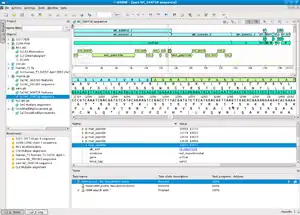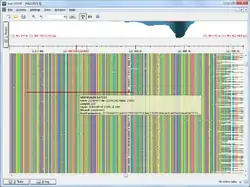UGENE
UGENE is computer software for bioinformatics.[1][2] It works on personal computer operating systems such as Windows, macOS, or Linux. It is released as free and open-source software, under a GNU General Public License (GPL) version 2.
 UGENE logo | |
 | |
| Original author(s) | Fursov M. |
|---|---|
| Developer(s) | Unipro |
| Initial release | 2008 |
| Stable release | 37
/ 14 December 2020 |
| Written in | C++, Qt |
| Operating system | Windows, macOS, Linux |
| Available in | English, Russian |
| Type | Bioinformatics toolkit |
| License | GPLv2 |
| Website | ugene |
UGENE helps biologists to analyze various biological genetics data, such as sequences, annotations, multiple alignments, phylogenetic trees, NGS assemblies, and others. The data can be stored both locally (on a personal computer) and on a shared storage (e.g., a lab database).
UGENE integrates dozens of well-known biological tools, algorithms, and original tools in the context of genomics, evolutionary biology, virology, and other branches of life science. UGENE provides a graphical user interface (GUI) for the pre-built tools so biologists with no computer programming skills can access those tools more easily.
Using UGENE Workflow Designer, it is possible to streamline a multi-step analysis. The workflow consists of blocks such as data readers, blocks executing embedded tools and algorithms, and data writers. Blocks can be created with command line tools or a script. A set of sample workflows is available in the Workflow Designer, to annotate sequences, convert data formats, analyze NGS data, etc.
Beside the graphical interface, UGENE also has a command-line interface. Workflows may also be executed thereby.
To improve performance, UGENE uses multi-core processors (CPUs) and graphics processing units (GPUs) to optimize a few algorithms.[3][4]
Key features
The software supports the following features:
- Create, edit, and annotate nucleic acid and protein sequences
- Fast search in a sequence
- Multiple sequence alignment: Clustal W and O, MUSCLE, Kalign, MAFFT, T-Coffee
- Create and use shared storage, e.g., lab database
- Search through online databases: National Center for Biotechnology Information (NCBI), Protein Data Bank (PDB), UniProtKB/Swiss-Prot, UniProtKB/TrEMBL, DAS servers
- Local and NCBI Genbank BLAST search
- Open reading frame finder
- Restriction enzyme finder with integrated REBASE[5] restriction enzymes list
- Integrated Primer3 package[6] for PCR primer design
- Plasmid construction and annotation
- Cloning in silico by designing of cloning vectors
- Genome mapping of short reads with Bowtie, BWA,[7] and UGENE Genome Aligner
- Visualize next generation sequencing data (BAM files) using UGENE Assembly Browser
- Variant calling with SAMtools[8]
- RNA-Seq data analysis with Tuxedo pipeline (TopHat,[9] Cufflinks,[10] etc.)
- ChIP-seq data analysis with Cistrome pipeline (MACS,[11] CEAS,[12] etc.)
- Raw NGS data processing
- HMMER 2 and 3 packages integration
- Chromatogram viewer
- Search for transcription factor binding sites (TFBS) with weight matrix and SITECON algorithms
- Search for direct, inverted, and tandem repeats in DNA sequences
- Local sequence alignment with optimized Smith-Waterman algorithm
- Build (using integrated PHYLIP neighbor joining, MrBayes,[13] or PhyML[14] Maximum Likelihood) and edit phylogenetic trees
- Combine various algorithms into custom workflows with UGENE Workflow Designer
- Contigs assembly with CAP3[15]
- 3D structure viewer for files in Protein Data Bank (PDB) and Molecular Modeling Database (MMDB)[16] formats, anaglyph view support
- Predict protein secondary structure with GOR IV and PSIPRED algorithms
- Construct dot plots for nucleic acid sequences
- mRNA alignment with Spidey[17]
- Search for complex signals with ExpertDiscovery[18]
- Search for a pattern of various algorithms' results in a nucleic acid sequence with UGENE Query Designer
- PCR in silico for primer designing and mapping
- Spade de novo assembler
Sequence View
The Sequence View is used to visualize, analyze and modify nucleic acid or protein sequences. Depending on the sequence type and the options selected, the following views can be present in the Sequence View window:
- 3D structure view
- Circular view
- Chromatogram view
- Graphs View: GC-content, AG-content, and other
- Dot plot view
Alignment Editor
The Alignment Editor allows working with multiple nucleic acid or protein sequences - aligning them, editing the alignment, analyzing it, storing the consensus sequence, building a phylogenetic tree, and so on.
Phylogenetic Tree Viewer
The Phylogenetic Tree Viewer helps to visualize and edit phylogenetic trees. It is possible to synchronize a tree with the corresponding multiple alignment used to build the tree.
Assembly Browser

The Assembly Browser project was started in 2010 as an entry for Illumina iDEA Challenge 2011.[19] The browser allows users to visualize and browse large (up to hundreds of millions of short reads) next generation sequence assemblies. It supports SAM,[20] BAM (the binary version of SAM), and ACE formats. Before browsing assembly data in UGENE, an input file is converted to a UGENE database file automatically. This approach has its pros and cons. The pros are that this allows viewing the whole assembly, navigating in it, and going to well-covered regions rapidly. The cons are that a conversion may take time for a large file, and needs enough disk space to store the database.
Workflow Designer
UGENE Workflow Designer allows creating and running complex computational workflow schemas.[21]
The distinguishing feature of Workflow Designer, relative to other bioinformatics workflow management systems is that workflows are executed on a local computer. It helps to avoid data transfer issues, whereas other tools’ reliance on remote file storage and internet connectivity does not.
The elements that a workflow consists of correspond to the bulk of algorithms integrated into UGENE. Using Workflow Designer also allows creating custom workflow elements. The elements can be based on a command-line tool or a script.
Workflows are stored in a special text format. This allows their reuse, and transfer between users.
A workflow can be run using the graphical interface or launched from the command line. The graphical interface also allows controlling the workflow execution, storing the parameters, and so on.
There is an embedded library of workflow samples to convert, filter, and annotate data, with several pipelines to analyze NGS data developed in collaboration with NIH NIAID.[22] A wizard is available for each workflow sample.
Supported biological data formats
- Sequences and annotations: FASTA (.fa), GenBank (.gb), EMBL (.emb), GFF (.gff)
- Multiple sequence alignments: Clustal (.aln), MSF (.msf), Stockholm (.sto), Nexus (.nex)
- 3D structures: PDB (.pdb), MMDB (.prt)[16]
- Chromatograms: ABIF (.abi), SCF (.scf)
- Short reads: Sequence Alignment/Map(SAM) (.sam), binary version of SAM (.bam), ACE (.ace), FASTQ (.fastq)
- Phylogenetic trees: Newick (.nwk), PHYLIP (.phy)
- Other formats: Bairoch (enzymes info), HMM (HMMER profiles), PWM and PFM (position matrices), SNP and VCF4 (genome variations)
Release cycle
UGENE is primarily developed by Unipro LLC[23] with headquarters in Akademgorodok of Novosibirsk, Russia. Each iteration lasts about 1–2 months, followed by a new release. Development snapshots may also be downloaded.
The features to include in each release are mostly initiated by users.
See also
- Sequence alignment software
- Bioinformatics
- Computational biology
- List of open source bioinformatics software
References
- Okonechnikov K, Golosova O, Fursov M, the UGENE team (2012). "Unipro UGENE: a unified bioinformatics toolkit". Bioinformatics. 28 (8): 1166–7. doi:10.1093/bioinformatics/bts091. PMID 22368248.
- Fursov, M.; Novikova, O. (2008). "Multitasking software system for DNA analysis" (PDF). Proceedings of the Sixth International Conference on Bioinformatics of Genome Regulation and Structure. 1: 78. ISBN 978-5-91291-005-0.
- Fursov, M. Y.; Oshchepkov, D. Y; Novikova, O. S. (2009). "UGENE: interactive computational schemes for genome analysis" (PDF). Proceedings of the Fifth Moscow International Congress on Biotechnology. 3: 14–15. ISBN 978-5-7237-0372-8.
- Efremov, I. E.; Fursov, M. Y; Danilova, Yu. E. (2009). "UGENE: high performance genome analysis suite". Proceedings of the Fifth Moscow International Congress on Biotechnology. 2: 405–406. ISBN 978-5-7237-0372-8.
- "NEW REBASE HOME". rebase.neb.com. Retrieved 18 October 2019.
- "Primer3 Input (version 0.4.0)". bioinfo.ut.ee. Retrieved 18 October 2019.
- "Burrows-Wheeler Aligner". bio-bwa.sourceforge.net. Retrieved 18 October 2019.
- "SAMtools". samtools.sourceforge.net. Retrieved 18 October 2019.
- "TopHat". ccb.jhu.edu. Retrieved 18 October 2019.
- "IU Webmaster redirect". cufflinks.cbcb.umd.edu. Retrieved 18 October 2019.
- "MACS - Model-based Analysis for ChIP-Seq". liulab.dfci.harvard.edu. Retrieved 18 October 2019.
- "CEAS - Cis-regulatory Element Annotation System". liulab.dfci.harvard.edu. Retrieved 18 October 2019.
- "MrBayes | index". nbisweden.github.io. Retrieved 18 October 2019.
- "ATGC: PhyML". atgc.lirmm.fr. Retrieved 18 October 2019.
- CAP3
- "Macromolecular Structures Resource Group". www.ncbi.nlm.nih.gov. Retrieved 18 October 2019.
- "Spidey is superceded [sic] by Splign". www.ncbi.nlm.nih.gov. Retrieved 18 October 2019.
- Vaskin, Y.; Khomicheva, I.; Ignatieva, E.; Vityaev, E. (2012). "ExpertDiscovery and UGENE integrated system for intelligent analysis of regulatory regions of genes". In Silico Biology. 11 (3–4): 97–108. doi:10.3233/ISB-2012-0448. PMID 22935964.
- "Illumina - iDEA Challenge". Archived from the original on 2013-01-26. Retrieved 18 October 2019.
- "SAM" (PDF). Retrieved 18 October 2019.
- Fursov, M. Y.; Varlamov, A. (2009). "UGENE - A practical approach for complex computational analysis in molecular biology" (PDF). Proceedings of the 10th Annual Bioinformatics Open Source Conference: 7.
- "NIH: National Institute of Allergy and Infectious Diseases | Leading research to understand, treat, and prevent infectious, immunologic, and allergic diseases". www.niaid.nih.gov. Retrieved 18 October 2019.
- "УНИПРО, Новосибирский центр информационных технологий. | СОФТ. Разработка, тестирование, реинжиниринг, поддержка ПО". Retrieved 18 October 2019.